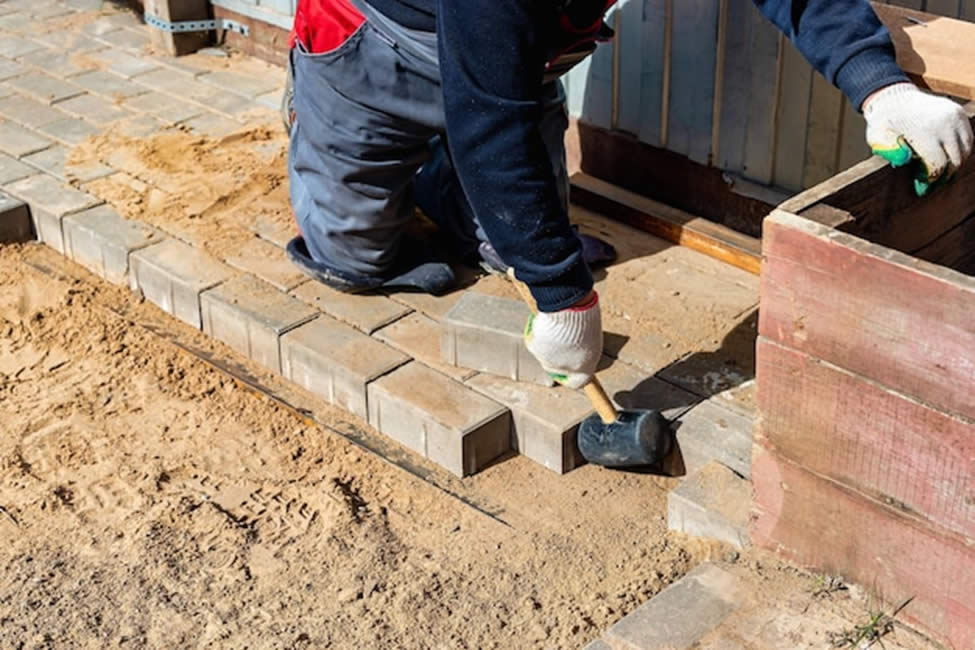Polymeric Sand
Polymeric sand is a type of synthetic granular material that’s increasingly being used to replace natural sand in brick paver patios. It’s cleaner, more economical, and has a more uniform grain size than typical river or quarry-derived sand. But there are some good reasons why you might want to consider other alternatives instead of polymeric sand.

Stone Dust
Stone dust is a fine sand that is made from crushed stone. Stone dust can be used as a base for paving stones and can be used in concrete, and asphalt mixes to add strength, reduce the amount of water needed, and help control bleeding. It’s also good at keeping ice from forming on walkways.
Concrete Dust
Concrete dust is a byproduct of concrete mixing. It is a fine powder that is produced during the mixing process, which can be used as an alternative to polymeric sand. While it’s cheaper than polymeric sand, it isn’t as durable and tends to clump if not mixed well when added to the masonry mix.
Concrete dust works best in poured concrete patios and sidewalks because they can handle heavier loads without cracking or breaking apart over time, like brick pavers would do if not properly reinforced with rebar rods placed throughout them (which would also increase their cost).
Aggregate Sand
Aggregate sand is made from crushed stone, and it’s used for building roads and driveways. This type of sand is not a good option for patios because it’s not as fine as polymeric sand, which makes it more difficult to spread properly. Additionally, aggregates are heavier than polymeric sands and will have an impact on the structural integrity of your patio flooring.
Aggregates come in different sizes, but they all have larger particles that can make spreading difficult if you don’t get the right grade. The coarsest grades are best suited for filling holes in walls or ground leveling; they’re not really suitable for general construction work because they’re too coarse-grained (or large) in size (a driveway made up entirely of large stones won’t look very nice).
Builder’s Sand
Builder’s sand, or coarse aggregate, is an unsorted or poorly sorted sand that’s manufactured from crushed stone (or other materials). It’s used as a base for concrete and other mixtures.
Builder’s sand has many uses in construction—it can be mixed with cement and gravel to make concrete, it can be used to fill cracks in asphalt and concrete, and it’s often the go-to material when you’re doing landscaping projects because of its inexpensive price tag.
While builder’s sand may be good for filling cracks in your foundation or mixing up cinder blocks on a job site, don’t use it as your patio surface! The particles are too large and will leave unsightly gaps between each brick edging piece used to create the border around your patio.
Plain Dust
Plain dust is just that: plain dirt. It won’t add any color or texture to your patio, but it will provide a base for the bricks and stones to sit on. If you want something more durable than plain sand, this is not the option for you; however, if you are looking for an inexpensive alternative that can be easily transported from site to site and poured into place with no prep work needed (aside from leveling), then plain dust might be what you’re looking for.
As far as durability goes, plain dust is less durable than other types of sand or polymer-based products because of its composition—it consists entirely of soil particles and doesn’t contain any additives or compounds to alter its water absorption or drainage properties like those found in other synthetic materials do. Therefore, when wet conditions persist after rainfall or irrigation events occur over a period of time during springtime months when vegetation is growing rapidly, causing runoff onto your new brick paver patio surface (and thus increasing moisture levels), there may be some erosion issues due simply being unable to retain enough liquid moisture before it drains off into surrounding areas such as lawns/gardens where no plants grow yet still absorb stormwater runoff!
Conclusion
As you can see, there are plenty of alternatives to polymeric sand that may suit your needs better. The key is to do your research and find out what makes the most sense for your project! Contact Platinum Pavers today for a free quote or more information.


